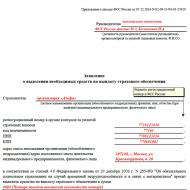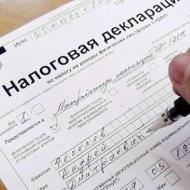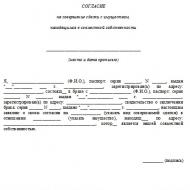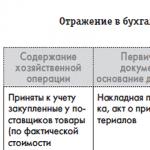
Rating of regions for the implementation of information systems. Monitoring of regional informatization. State management: Level of implementation of e-government
State Secretary - Deputy Minister of Communications and Mass Communications Russian Federation Oleg Pak within the framework of the Council for Regional Informatization Government Commission by use information technologies to improve the quality of life and living conditions entrepreneurial activity presented a rating of the constituent entities of the Russian Federation according to the level of development of the information society according to seven sub-indexes. The meeting was chaired by the head of the Russian Ministry of Telecom and Mass Communications, Nikolai Nikiforov. Representatives of federal executive authorities and constituent entities of the Russian Federation took part in the work of the council: deputy governors responsible for informatization in the regions, ministers of information and communications, directors of specialized departments.
Monitoring, reflecting the dynamics of development of regional informatization, is necessary to control the achievement of the goals of the Concept of regional informatization and implementation state program Russian Federation "Information Society (2011–2020)".
"We as a ministry this rating is needed to have an objective, comprehensive and detailed picture for each region, both in terms of infrastructure indicators for IT and in terms of the development of individual industries. Subjects can use this rating as an additional tool to attract the attention of their regional leaders to the topic of informatization, since not everyone considers this topic a priority,” said Oleg Pak.
To compile the rating, the Russian Ministry of Telecom and Mass Communications has developed an appropriate methodology that evaluates the level of regional informatization based on infrastructure and industry indicators. Infrastructure indicators include human capital, economic environment, ICT infrastructure and information management. The methodology will also take into account indicators of ICT use in 15 areas of activity. Among them are e-government, education, healthcare, culture, entrepreneurship and trade, Agriculture, transport, social management, housing and communal services and a number of others. In the future, 19 sub-indices will be used when compiling the rating.
The Ministry of Telecom and Mass Communications of the Russian Federation presented in October the rating of regions for the development of the information society for 2017.
Ugra occupies third position in this ranking, behind Moscow and the Tyumen region. The top ten also included the Republic of Tatarstan, Tula region, Novosibirsk region, Republic of Bashkortostan, Yamalo-Nenets autonomous region, Tomsk region and Chelyabinsk region.
To determine the leaders, an assessment methodology was used based on 120 indicators and 17 sub-indices. When calculating the location, the level of development of special information systems: GIS "Contingent", IS Transport Management, EGAIS, GIS GMP, System-112 and GIS "Energy Efficiency".
Among the priority sub-indexes: ICT infrastructure, e-government, ICT in education, ICT in healthcare, ICT in transport. The list of subindexes corresponds to the sections of the Concept for the Development of Regional Informatization.
When assessing the regions, development was taken into account in such projects as the transfer of public services into electronic form, the introduction of information systems for distance education, the introduction of ICT in educational process(electronic diary), making an appointment with a doctor, electronic card, telemedicine, introduction of electronic means of payment for travel, online traffic monitoring. Also, the success of the regions in the ranking was guaranteed by the creation of regional information systems in the field of energy, government and municipal finance; integration of regional information systems with federal ones and automation of the activities of libraries, museums and theaters.
2013: State management: Level of implementation of electronic government
According to the rating of subjects of the Russian Federation by the level of implementation of Electronic government as of February 1, 2013, published by GosManagement, at the beginning of the year the leaders in the implementation of e-government services were: in the Central Federal District - Moscow, Lipetsk and Belgorod regions, in the Northwestern Federal District - St. Petersburg, Arkhangelsk and Novgorod region, Southern Federal District - Rostov, Astrakhan regions and Krasnodar Territory, in the North Caucasian Federal District - KBR, Dagestan and Stavropol Territory, in the Volga Federal District - Nizhny Novgorod and Samara regions, as well as Tatarstan, in the Ural Federal District - Tyumen and Sverdlovsk regions, in the Siberian Federal District - Transbaikal, Krasnoyarsk region, in the Far Eastern Federal District - Jewish Autonomous Okrug, Khabarovsk Territory, Yakutia.
State management, February 2013
2012: State management: Level of implementation of electronic government
The rating of the constituent entities of the Russian Federation in terms of the level of implementation of Electronic government as of April 1, 2012, published by the publication "State Management", indicates that in terms of the level of development electronic services leaders in the Central Federal District - Moscow, Lipetsk region and Belgorod region, in the Southern Federal District - Krasnodar Territory, Rostov and Volgograd regions, in the North Caucasus Federal District - Kabardino-Balkaria, Stavropol Territory and Dagestan, in the Volga Federal District - Nizhny Novgorod Region, Tatarstan and Samara Region, in the Ural Federal District - Tyumen region, Khanty-Mansi Autonomous Okrug and Yamalo-Nenets Autonomous Okrug, in the Siberian Federal District - Omsk region, Transbaikal region, Tomsk region, in the Far Eastern Federal District - Jewish Autonomous Okrug, Sakhalin region, Khabarovsk Territory.
2011
IRS: Index of Regions' Readiness for the Information Society
“Digital inequality” of the constituent entities of the Russian Federation, which is described in detail in the annual reports of the Institute for the Development of the Information Society (). In fact, this means that, due to historical, economic, geographical, managerial and other reasons, the level of penetration of certain high technologies differs significantly from region to region.
Index of regional readiness for the information society

Institute for Information Society Development, IIS
The most complete reflection of the situation with regional informatization in the Russian Federation is presented in the Index of Readiness of Russian Regions for the Information Society, which has been published by IIS since 2005. The index is a measure of the degree of preparedness of regions for the large-scale use of ICT for socio-economic development. It is calculated based on indicators characterizing the factors of development of the information society (human capital, economic environment and ICT infrastructure), as well as the use of ICT in six areas (state and municipal administration, education, healthcare, business, culture, households).
According to the latest Index, based on data for 2009-2010, information inequality among the constituent entities of the Russian Federation is still quite serious. The top ten regions with the maximum number of points included Moscow, St. Petersburg, Yamalo-Nenets Autonomous Okrug, Tomsk Region, Khanty-Mansiysk Autonomous Okrug, Tyumen Region, Chukotka Autonomous Okrug, Murmansk Region, Chuvashia and the Republic of Karelia. At the same time, at the very end of the index list there are such regions as, for example, Kursk region, Tambov region, Kalmykia, Tyva, Dagestan, Ingushetia and others.
“Digital inequality” in numbers

Institute for the Development of the Information Society, IIS, 2011
The goals of the new state program “Information Society”, among other things, are to reduce the digital divide in regions, develop e-government services and further develop the ICT market.
NAIRIT: Innovative activity of regions
According to the 2011 Regional Innovation Activity Rating, prepared by the National Association of Innovation and Information Technology Development (NAIRIT), Moscow once again became the leader in innovation activity. For the first time, compared to previous studies, the gap between the capital and its closest pursuers in the rating began to shrink and amounted to 15 The second place was taken by the Republic of Tatarstan (last year it was 4th in the ranking).
The main “losers” of the rating include the Moscow region (a drop in the ranking by 27 positions), Kamchatka Krai(a drop in the ranking by 12 positions) and the Voronezh region (11 positions). In general, approximately 9% of its participants managed to maintain their positions in the ranking. About 42% of regions increased their activity. 49%, on the contrary, showed results lower than last year. At the same time, the number of regions in the category “Low innovative activity” remained unchanged compared to last year. The number of regions in the “High Innovation Activity” category increased by only one participant. Eventually general indicator innovation activity for 2011 was almost at the same level (higher by 1.5%) as the same indicator for 2010.
Moscow, April 21, 2016.— State Secretary - Deputy Minister of Communications and Mass Communications of the Russian Federation Oleg Pak, within the framework of the Council for Regional Informatization of the Government Commission on the use of information technologies to improve the quality of life and conditions for doing business, presented a rating of the constituent entities of the Russian Federation according to the level of development of the information society according to seven sub-indexes. The meeting was chaired by the head of the Russian Ministry of Telecom and Mass Communications, Nikolai Nikiforov. Representatives of federal executive authorities and constituent entities of the Russian Federation took part in the work of the council: deputy governors responsible for informatization in the regions, ministers of information and communications, directors of specialized departments.
Monitoring, reflecting the dynamics of development of regional informatization, is necessary to control the achievement of the goals of the Concept of Regional Informatization and the implementation of the state program of the Russian Federation “Information Society (2011-2020)”.
“We, as a ministry, need this rating in order to have an objective, comprehensive and detailed picture for each region, both in terms of infrastructure indicators for IT and in terms of the development of individual industries. Subjects can use this rating as an additional tool to attract the attention of their regional leaders to the topic of informatization, since this topic is not a priority for everyone,” said Oleg Pak.









At the regional informatization council held on October 13, the Ministry of Telecom and Mass Communications presented a rating of regions for the development of the information society in the Russian Federation for 2017.
The regions that, according to the Ministry of Telecom and Mass Communications, “advanced” due to the implementation of the first strategy included the Republics of Bashkortostan, Mordovia, Tatarstan, Kursk and Tomsk regions. Examples of implemented projects include the development of ICT infrastructure, the transfer of public services into electronic form, the introduction of distance education information systems, the introduction of ICT into the educational process (electronic diary), making an appointment with a doctor, an electronic card, telemedicine, the introduction of electronic means of payment for travel, online motion monitoring.
Due to the choice of the second strategy, we rose in the ranking Udmurt republic and Tula, Chelyabinsk, Ulyanovsk Rostov regions. Among the implemented projects are the creation of regional information systems in the energy sector, the integration of regional information systems with federal information systems (social security, labor and employment, agriculture), automation of the activities of libraries, museums and theaters, the creation of regional information systems in the field of state and municipal finance.
| 1 | Moscow |
| 2 | Tyumen region |
| 3 | Khanty-Mansiysk Autonomous Okrug-Yugra |
| 4 | Republic of Tatarstan |
| 5 | Tula region |
| 6 | Novosibirsk region |
| 7 | Republic of Bashkortostan |
| 8 | Yamalo-Nenets Autonomous Okrug |
| 9 | Tomsk region |
| 10 | Chelyabinsk region |
| 11 | Saint Petersburg |
| 12 | Yaroslavl region |
| 13 | The Republic of Mordovia |
| 14 | Lipetsk region |
| 15 | Rostov region |
| 16 | Kaliningrad region |
| 17 | Ulyanovsk region |
| 18 | Murmansk region |
| 19 | Voronezh region |
| 20 | Amur region |
| 21 | Belgorod region |
| 22 | Altai Republic |
| 23 | Vladimir region |
| 24 | The Republic of Sakha (Yakutia) |
| 25 | Samara Region |
| 26 | Kursk region |
| 27 | Udmurt republic |
| 28 | Chuvash Republic |
| 29 | Vologda Region |
| 30 | Kaluga region |
| 31 | Orenburg region |
| 32 | Irkutsk region |
| 33 | Komi Republic |
| 34 | Novgorod region |
| 35 | Perm region |
| 36 | Astrakhan region |
| 37 | Altai region |
| 38 | Tambov Region |
| 39 | Volgograd region |
| 40 | Omsk region |
| 41 | Arhangelsk region |
| 42 | Kemerovo region |
| 43 | Kabardino-Balkarian Republic |
| 44 | Ivanovo region |
| 45 | Sakhalin region |
| 46 | Kostroma region |
| 47 | Khabarovsk region |
| 48 | Kamchatka Krai |
| 49 | Mari El Republic |
| 50 | Kirov region |
| 51 | Saratov region |
| 52 | Stavropol region |
| 53 | Ryazan Oblast |
| 54 | Krasnoyarsk region |
| 55 | Republic of Karelia |
| 56 | Krasnodar region |
| 57 | Nizhny Novgorod Region |
| 58 | The Republic of Khakassia |
| 59 | Smolensk region |
| 60 | Oryol Region |
| 61 | Kurgan region |
| 62 | Tver region |
| 63 | Sverdlovsk region |
| 64 | Pskov region |
| 65 | Primorsky Krai |
| 66 | Penza region |
| 67 | Transbaikal region |
| 68 | The Republic of Buryatia |
| 69 | Nenets Autonomous Okrug |
| 70 | Magadan Region |
| 71 | Republic of Adygea |
| 72 | Republic of North Ossetia-Alania |
| 73 | Bryansk region |
| 74 | Republic of Kalmykia |
| 75 | The Republic of Dagestan |
| 76 | The Republic of Ingushetia |
| 77 | Karachay-Cherkess Republic |
| 78 | Tyva Republic |
| 79 | Chukotka Autonomous Okrug |
| 80 | Sevastopol |
| 81 | Jewish Autonomous Region |
| 82 | Chechen Republic |
| 83 | Republic of Crimea |
In 2016, the Ministry of Telecom and Mass Communications of Russia, as part of monitoring the level of development of the information society in the constituent entities of the Russian Federation, presented for the first time a rating of the constituent entities of the Russian Federation according to the level of development of the information society, within which the constituent entities of the Russian Federation were divided into five groups in accordance with achieved level informatization.
The five leading regions in terms of the level of development of the information society include cities of federal significance - Moscow and St. Petersburg, the largest export-oriented (oil and gas) regions of the Russian Federation - the Khanty-Mansiysk Autonomous Okrug-Yugra and the Yamalo-Nenets Autonomous Okrug, as well as the dynamically developing Kaliningrad region.
The rating of the constituent entities of the Russian Federation was formed on the basis of a methodology for assessing the level of development of the information society in the constituent entities of the Russian Federation, developed in accordance with the provisions of the Concept of Regional Informatization, approved by Decree of the Government of the Russian Federation No. 2769-r dated December 29, 2014.
The methodology establishes the procedure for calculating the information society development index in the constituent entities of the Russian Federation, on the basis of which the level of regional informatization is assessed based on infrastructure and industry indicators. Infrastructure indicators include human capital, economic environment, ICT infrastructure and information management. The methodology also involves taking into account indicators of the use of ICT in 15 areas of activity. Among them are e-government, education, healthcare, culture, entrepreneurship and trade, agriculture, transport, social management, housing and communal services and a number of others. In 2017, 19 sub-indices will be used to compile the rating.
The methodology was approved by the minutes of the 172nd meeting of the Council on Regional Informatization of the Government Commission on the use of information technologies to improve the quality of life and conditions for doing business on April 20, 2016.
In order to increase the completeness, reliability and relevance of the data used in assessing the constituent entities of the Russian Federation, as well as their systematization and analysis, the Russian Ministry of Telecom and Mass Communications has developed an information system (AIS) “Electronic Region”.
The “Electronic Region” system consists of several functional blocks that make it possible to generate informatization passports for the constituent entities of the Russian Federation, containing key indicators of informatization development. Informatization passports are generated based on data collected during monitoring, as well as integration with various information systems, including the federal register public services, a unified interdepartmental information and statistical system, a situational center for electronic government.
Also, AIS “Electronic Region” allows you to automate the process of collecting and processing monitoring data; display the rating of the constituent entities of the Russian Federation according to the level of development of the information society in graphical form; generate analytical reports on indicators of the level of development of the information society.
















